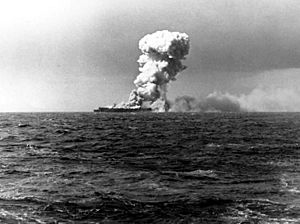Battle of Leyte Gulf facts for kids
Quick facts for kids Battle of Leyte Gulf |
|||||||
|---|---|---|---|---|---|---|---|
| Part of the Pacific War, World War II | |||||||
 The light aircraft carrier USS Princeton afire, east of Luzon, 24 October 1944. |
|||||||
|
|||||||
| Belligerents | |||||||
| Commanders and leaders | |||||||
(3rd Fleet) (7th Fleet) |
|||||||
| Strength | |||||||
| 8 fleet carriers 8 light carriers 18 escort carriers 12 battleships 24 cruisers 141 destroyers and destroyer escorts Many PT boats, submarines, and fleet auxiliaries About 1,500 planes |
1 fleet carrier 3 light carriers 9 battleships 14 heavy cruisers 6 light cruisers 35+ destroyers 300+ planes (including land-based aircraft) |
||||||
| Casualties and losses | |||||||
| ~2,800 dead; 1 light aircraft carrier, 2 escort carriers, 2 destroyers, 1 destroyer escort sunk 200+ planes |
~10,500 dead; 1 fleet carrier, 3 light carriers 3 battleships, 10 cruisers, 11 destroyers sunk ~500 planes |
||||||
The Battle of Leyte Gulf was the largest sea battle in modern history. It was a major part of World War II. This huge battle happened in the waters near the Philippine island of Leyte.
It took place from October 23 to October 26, 1944. The battle was fought between the Allied forces and the Empire of Japan.
Contents
Why Was This Battle Fought?
The Allies wanted to cut off Japan's supply routes. Japan got most of its oil and other important resources from its colonies in Southeast Asia. By controlling the seas around the Philippines, the Allies could stop these supplies.
Japan gathered almost all its remaining ships for this fight. They hoped to stop the Allied advance. However, the Japanese forces lost many ships and aircraft.
What Happened After the Battle?
The Battle of Leyte Gulf was the last major naval battle of World War II. After this huge loss, the Imperial Japanese Navy could no longer fight big sea battles. They had lost too many ships and, more importantly, their fuel supply was cut off.
Most of their remaining ships returned to Japan. They stayed there and did not fight for the rest of the war.
The Kamikaze Attacks
This battle also saw the first major use of kamikaze aircraft. Kamikaze pilots were Japanese pilots who deliberately crashed their planes into enemy ships. They aimed to cause as much damage as possible.
The first kamikaze attack in this battle hit the Australian main ship, HMAS Australia, on October 21. Many other such attacks by the "Special Attack Force" started on October 25. These attacks caused a lot of damage to the Allied ships.
Main Parts of the Battle
The Battle of Leyte Gulf was not just one big fight. It was a series of four major naval actions. These happened in different areas around the Philippines.
- The Battle of the Sibuyan Sea
- The Battle of Surigao Strait
- The Battle off Cape Engaño
- The Battle off Samar
These separate battles all contributed to the overall Allied victory.
Images for kids
-
Musashi departing Brunei in October 1944 for the Battle of Leyte Gulf
-
Yamato hit by a bomb near her forward gun turret in the Sibuyan Sea, 24 October 1944
-
St. Lo exploding after a kamikaze strike.
-
The Japanese aircraft carriers Zuikaku, left, and (probably) Zuihō come under attack by dive bombers early in the Battle off Cape Engaño.
-
The crew of Zuikaku salute as the flag is lowered on the listing carrier after an airstrike. She was the last carrier participating in the attack on Pearl Harbor to be sunk.
-
Admiral William F. "Bull" Halsey – Commander U.S. Third Fleet at Leyte Gulf
-
A 60th-anniversary memorial ceremony in Palo, Leyte, Philippines, on 20 October 2004
See also
 In Spanish: Batalla del golfo de Leyte para niños
In Spanish: Batalla del golfo de Leyte para niños















